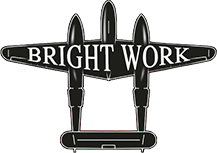When the winter’s over and a new season begins, it's time to think about ways…
FAQs About Polishing Your Aircraft
At Bright Work, we consider ourselves to be experts in aircraft polishing, so it makes sense that our customers often ask us questions related to the best practices for polishing an aircraft. We’ve decided to share the answers to some of the most frequently asked questions on this topic so you don’t have to search the web for the information you need.
Why is it so important to wash your aircraft before polishing it?
Before polishing your aircraft, it’s important that you wash the exterior surface. Why? Washing the surface removes any dirt or debris that has accumulated on your aircraft. If any dirt or debris remains on your plane, it’s possible that it will scratch the surface as you move across it with an electric buffer. For this same reason, it’s also important to double check that you are using clean cloths and buffing pads when washing or polishing your aircraft. If you have to put a tool down, never put it on the ground unless there is something like a clean sheet or towel between the tool and the ground.
How often should you polish an aircraft?
Pilots can choose to polish their planes as often as they would like. Some pilots polish their planes more often than they need to because they enjoy seeing it look brand new again. If you don’t have the time to polish it as much as you’d like, it’s important to recognize the signs that your aircraft actually needs to be polished. It’s recommended that you polish an aircraft before putting it in storage for a long period of time so you can remove spots and other damage from the surface before they get worse. You should also make time to polish your aircraft when you notice oxidation, water spots, or cloudiness forming on the exterior surface. If you don’t take care of these issues as they arise, it’s possible that they will become worse over time.
Many pilots also polish their aircrafts when they plan on flying it to an air show or taking a trip in it to see friends or family. These pilots understand that polish helps planes look their best.
Can you use car polish on an airplane?
Many pilots assume that any type of polish will work on their aircraft, but that’s not the case. It’s important that you choose a polish that has been aviation-approved, which means it is designed specifically for planes. Some car polish products will note on the packaging that they can be safely used on aircrafts, but that doesn’t mean you should do it. Cars and airplanes are very different, which means they don’t have similar needs. Car polishes are designed to work well on the automotive materials and protect cars against harsh environmental elements, however they may not be effective in protecting airplane materials against the environmental elements they face in the sky. Be sure that you check the label of any polish that you purchase to ensure it says that the product has been aviation approved.
How can you reach every nook and cranny of an aircraft with an electric buffer?
Using an electric buffer makes polishing your aircraft much easier and less time-consuming. However, it can be difficult to reach every nook and cranny with such a bulky tool. To ensure that every inch of your plane’s exterior surface has been properly polished, switch back and forth between polishing by hand and using a machine. The electric buffer should be used to polish large, easy-to-reach surfaces on the aircraft. When you reach an area that you can’t get to with the buffer, turn it off and polish this area by hand.
What tools do you need to polish an aircraft?
Gather all of the supplies that you need before you begin polishing so you don’t have to stop for any reason once you start. Besides the polish, you will also need an electric buffer machine with a strong motor that is small enough for you to handle without struggling. You will also need buffing pads in order to polish your aircraft. There are many different types of buffing pads, but it’s recommended that you use a wool pad in the beginning to remove wax and sealant from the surface. Then, switch to a softer foam pad to ensure your plane is left with a beautiful shine. The pads may become dirty from the dirt and grime on the surface of your plane. To avoid smearing this dirt across your aircraft, stop polishing every so often to clean the pad. You can use a soft-bristled brush to gently clean the pads before you start polishing again. It’s also a good idea to have soft cloths on hand to finish the polishing job.
What happens if you use two different kinds of polish on your aircraft?
Aviation experts recommend that you only use one type of polish on your aircraft. Why does it matter? If you use two or more different types of polish on the same area of your aircraft, it’s possible that the chemicals in the polishes will react with each other and cause discoloration. If you need to test different polishes to determine which one you should use on your plane, test each polish on a small area that is hidden so no one can see any discoloration that may occur.
Now that you know the ins and outs of polishing an aircraft, it’s time to buy the three polishes that you need to get started. Head to our online shop to get our red, white, and blue Bright Work polishes so you can remove oxidation, corrosion, water spots, and other marks on the exterior surface of your plane!

This Post Has 0 Comments